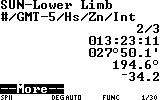I don't want to see myself spending 15 to 30 minutes determining a fix, while thumbing through multiple tables, making mistakes and getting sea sick while below.
All sights were taken with a Davis Mark 25 plastic sextant through an artificial horizon - under near perfect viewing conditions. All sights were taken at local time and adjusted for watch error. Each sight session consisted of 3 sights and averaged.
All worksheet sights were reduced via Pub 249 Vol 3 Tables.
From the following:
Course and Speed: 000d 0Kn (Stone Frigate)
Actual Position: N43d43.0' W079d24.0'
DR: N43d W079d
Date: 1 Feb 2016
Sight #1 Sun UL
UTC = 15:50:09
Hs = 25d16.8'
Lon AP = 079d09.7'
Sight #2 Sun LL
UTC = 18:23:11
Hs = 27d50.1'
Lon AP = 079d24.9'
Sight #3 Sun LL
UTC = 20:10:15
Hs = 19d00.1'
The results: Worksheet StarPilot
Sight #1 Zn = 153d T Zn = 153.5d T
Int = 39' A Int = 42.3 A
Sight #2 Zn = 194d T Zn = 194.6d T
Int = 38' A Int = 34.2 A
Sight #3 Zn = 221d T Zn = 220.9d T
Int = 21' A Int = 16.6' A
Fix N 43d 38.0' N 43d 38.9'
W 079d 27.0' W 079d 24.9'
Accuracy within 7 nm within 5 nm
With StarPilot...
- DR is the AP
- a bit more accurate
- takes about 2 minutes versus 15 to 20 minutes to determine a fix
- keep spare batteries and sea water out - no solar power
Clearly the Starpilot approach is very accurate and very quick to produce a fix and I can't wait to do the real thing on the water.
Here are the Worksheets and the Plot...
 |
| Sun Sight #1 |
 |
| Sun Sight #2 |
 |
| Sun Sight #3 |
 |
| Plotting Sheet Comparing Worksheet and StarPilot (in Red) |





No comments:
Post a Comment